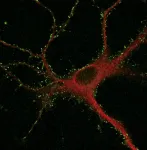Tracking receptor proteins can unveil molecular basis of memory and learning
Scientists from Japan employ a novel two-step method of labeling neurotransmitter receptor proteins to track their localization efficiently
2021-04-03
(Press-News.org) The neurons in our nervous system "talk" to each other by sending and receiving chemical messages called neurotransmitters. This communication is facilitated by cell membrane proteins called receptors, which pick up neurotransmitters and relay them across cells. In a recent study published in Nature Communications, scientists from Japan report their findings on the dynamics of receptors, which can enable understanding of the processes of memory formation and learning.
The regulation of receptor movement and localization within the neuron is important for synaptic plasticity, an important process in the central nervous system. A specific type of glutamate receptor, known as AMPA-type glutamate receptor (AMPAR), undergoes a constant cycle of "trafficking", being cycled in and out of the neuronal membrane. "A precise regulation of this 'trafficking' process is associated with learning, memory formation, and development in neural circuits," says Professor Shigeki Kiyonaka from Nagoya University, Japan, who led the aforementioned study.
While methods to analyze the trafficking of AMPARs are available aplenty, each has its limitations. Biochemical approaches include "tagging" a receptor protein with biotin (a B vitamin). However, this requires purification of the proteins after tagging, hindering quantitative analysis. Another method which involves producing "fusion" receptor proteins labelled with a fluorescent protein may interfere with the trafficking process itself. "In most cases, these methods largely rely on the overexpression of target subunits. However, the overexpression of a single receptor subunit may interfere with the localization and/or trafficking of native receptors in neurons", explains Prof. Kiyonaka.
To that end, researchers from Nagoya University, Kyoto University, and Keio University developed an AMPAR-selective reagent (a chemical agent that causes reactions) that allowed them to label AMPARs with chemical probes in cultured neurons in a two-step manner, combining affinity-based labeling with a biocompatible reaction. The new method, as anticipated by Prof. Kiyonaka, proved to be superior to the conventional ones: it allowed scientists to analyze receptor trafficking over both shorter as well as much longer periods (over 120 hours) and did not require extra purification steps after labeling.
The team's analyses showed a three-fold higher concentration of AMPARs at synapses compared with dendrites as well as a half-life of 33 hours in neurons. Additionally, scientists used this technique to label and analyze the trafficking of NMDA-type glutamate receptors (NMDARs), and obtained a half-life of 22 hours in neurons. Interestingly, both half-life values were significantly longer than those reported in HEK293T (a kidney cell line). The researchers attributed this to the formation of large glutamate receptor protein complexes and -- in the case of AMPARs -- a difference in phosphorylation levels.
The team is excited by potential implications of their findings. "Our method can contribute to our understanding of the physiological and pathophysiological roles of glutamate receptor trafficking in neurons. This, in turn, can help us understand the molecular mechanism underlying memory formation and the process of learning," says Prof. Kiyonaka.
The study provides a closer look at -- and brings us a step closer to deciphering -- the processes of memory and learning at the molecular level.
INFORMATION:
The paper, "Ligand-directed two-step labeling to quantify neuronal glutamate receptor trafficking," was published in the journal Nature Communications on February 5, 2021, at DOI: 10.1038/s41467-021-21082-x.
Authors:
Kento Ojima, Kazuki Shiraiwa, Kyohei Soga, Tomohiro Doura, Mikiko Takato, Kazuhiro Komatsu, Michisuke Yuzaki, Itaru Hamachi, and Shigeki Kiyonaka
About Nagoya University, Japan
Nagoya University has a history of about 150 years, with its roots in a temporary medical school and hospital established in 1871, and was formally instituted as the last Imperial University of Japan in 1939. Although modest in size compared to the largest universities in Japan, Nagoya University has been pursuing excellence since its founding. Six of the 18 Japanese Nobel Prize-winners since 2000 did all or part of their Nobel Prize-winning work at Nagoya University: four in Physics - Toshihide Maskawa and Makoto Kobayashi in 2008, and Isamu Akasaki and Hiroshi Amano in 2014; and two in Chemistry - Ryoji Noyori in 2001 and Osamu Shimomura in 2008. In mathematics, Shigefumi Mori did his Fields Medal-winning work at the University. A number of other important discoveries have also been made at the University, including the Okazaki DNA Fragments by Reiji and Tsuneko Okazaki in the 1960s; and depletion forces by Sho Asakura and Fumio Oosawa in 1954.
Website: http://en.nagoya-u.ac.jp/
[Attachments] See images for this press release:

ELSE PRESS RELEASES FROM THIS DATE:
2021-04-03
DEPRIVATION among society at large is 'driving' Covid-19 disparities among minority ethnic groups - predominantly South Asian and Black African or Caribbean populations - and could be considered the main cause of disproportionate infection rates, hospitalisation and deaths experienced by these populations, according to new analysis from the University of Leicester.
The study, supported by the National Institute for Health Research (NIHR) Leicester Biomedical Research Centre (BRC) comes a day after a government-commissioned review concluded race and racism have become less important factors in explaining social disparities in the UK.
Researchers at the University of Leicester used UK Biobank data of 407,830 South Asian, Black ...
2021-04-03
Waiting for your turn can be frustrating, especially when it comes to COVID-19 vaccinations. But prioritizing who receives the limited supply of vaccines available saves lives and reduces spread of infection, according to a study published today in the journal PNAS from the University of California, Davis.
While there is mostly universal agreement that older people should be prioritized, debates are currently underway about prioritizing a variety of other groups. Still others argue against targeting at all.
"Prioritization has benefits because people differ in at least two key ways -- their risk of infection and the likelihood of serious consequences from infection," said senior author ...
2021-04-02
Within southeast Michigan's Middle Eastern and North African community, those who worry about deportation or believe they've been treated unfairly are likely to face more adverse conditions associated with poor health, including food insecurity and financial distress.
The MENA people who face several of these barriers are also more likely to report chronic illness and mental health issues as well as worse overall health.
That's according to a new study by the University of Michigan Rogel Cancer Center, the University of Michigan School of Public Health, and the Arab Community Center for ...
2021-04-02
Washington, April 2, 2021--The Organisation for Economic Co-operation and Development (OECD) will release a new PISA report on student growth mindset on Thursday, April 8 at 5:00 a.m. ET, followed by a press conference held in collaboration with the American Educational Research Association (AERA) and the Yidan Prize Foundation at 10:30 a.m. ET.
The new report "Sky's the limit: Growth mindset, students, and schools in PISA" provides analyses on student growth mindset, a concept much discussed in the current field of psychology. Growth mindset is the belief that someone's ability and intelligence can be developed over time. PISA collected international ...
2021-04-02
BOSTON - New research led by investigators at Massachusetts General Hospital (MGH) provides insights on why people with red hair exhibit altered sensitivity to certain kinds of pain. The findings are published in Science Advances.
In people with red hair (as in numerous other species of animals with red fur), the pigment-producing cells of the skin--called melanocytes--contain a variant form of the melanocortin 1 receptor. This receptor sits on the cell surface, and if it becomes activated by circulating hormones called melanocortins, it causes the melanocyte to switch from generating yellow/red melanin pigment to producing brown/black melanin pigment. Earlier work by David E. Fisher, MD, PhD, director of the Mass General Cancer Center's ...
2021-04-02
PHILADELPHIA - A team led by scientists in the Perelman School of Medicine at the University of Pennsylvania has identified nine potential new COVID-19 treatments, including three that are already approved by the Food and Drug Administration (FDA) for treating other diseases.
The team, whose findings were published in Cell Reports, screened thousands of existing drugs and drug-like molecules for their ability to inhibit the replication of the COVID-19-causing coronavirus, SARS-CoV-2. In contrast to many prior studies, the screens tested the molecules for anti-coronaviral activity in a variety of cell types, including human airway-lining cells that are similar to the ones principally affected in COVID-19.
Of ...
2021-04-02
A new Veterans Affairs study finds that combat experience is associated with a higher risk of alcohol use to cope with PTSD symptoms. But the connection is weaker when accounting for the severity of the PTSD.
The findings appeared online in the Journal of Dual Diagnosis in March 2021.
In an observational study of more than 11,000 men with at least one traumatic experience, the researchers found that those with combat experience were much more likely than those without to report drinking alcohol to cope with PTSD. The diversity of traumatic experiences, the severity of PTSD, and diagnoses ...
2021-04-02
Aquaculture--the farming of fish, shellfish, and other aquatic animals for food--has reached unprecedented levels of growth in recent years, but largely without consideration of its impact on individual animals, finds a new analysis by a team of researchers.
"The scale of modern aquaculture is immense and still growing," says Becca Franks, a research scientist at New York University's Department of Environmental Studies and the lead author of the paper, which appears in the journal Science Advances. "Yet we know so little about the animals that we are putting into mass production, ...
2021-04-02
ANN ARBOR--We are made of stardust, the saying goes, and a pair of studies including University of Michigan research finds that may be more true than we previously thought.
The first study, led by U-M researcher END ...
2021-04-02
WEHI researchers have discovered a key differentiation process that provides an essential immune function in helping to control cancer and infectious diseases.
The research, published in Science Immunology, is the first to show a new factor - DC-SCRIPT - is required for the function a particular type of dendritic cell - called cDC1 - that is essential in controlling the immune response to infection.
Led by WEHI Professor Stephen Nutt, Dr Michael Chopin and Mr Shengbo Zhang, it defines the role for a new regulatory protein - DC-SCRIPT - in producing dendritic cells.
At a glance
WEHI researchers have uncovered a key step in the formation of a particular type of dendritic cell - called cDC1 - in controlling ...
LAST 30 PRESS RELEASES:
[Press-News.org] Tracking receptor proteins can unveil molecular basis of memory and learning
Scientists from Japan employ a novel two-step method of labeling neurotransmitter receptor proteins to track their localization efficiently



